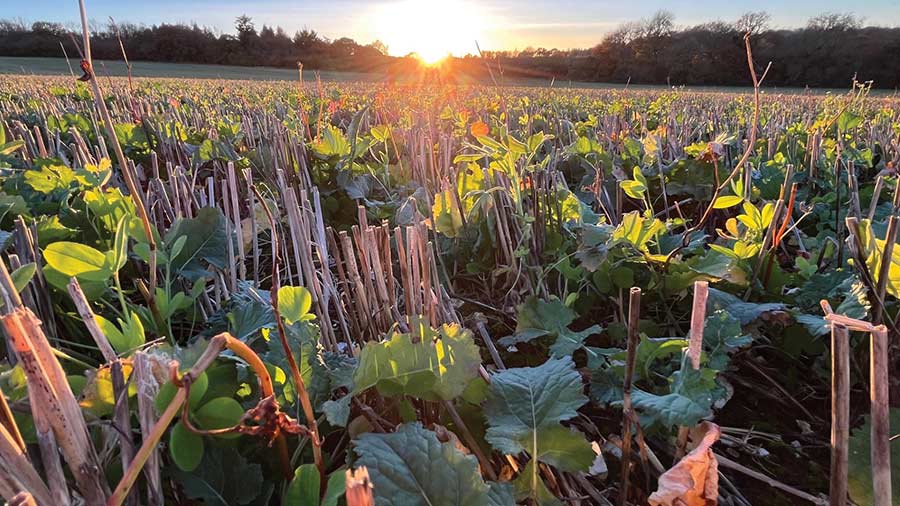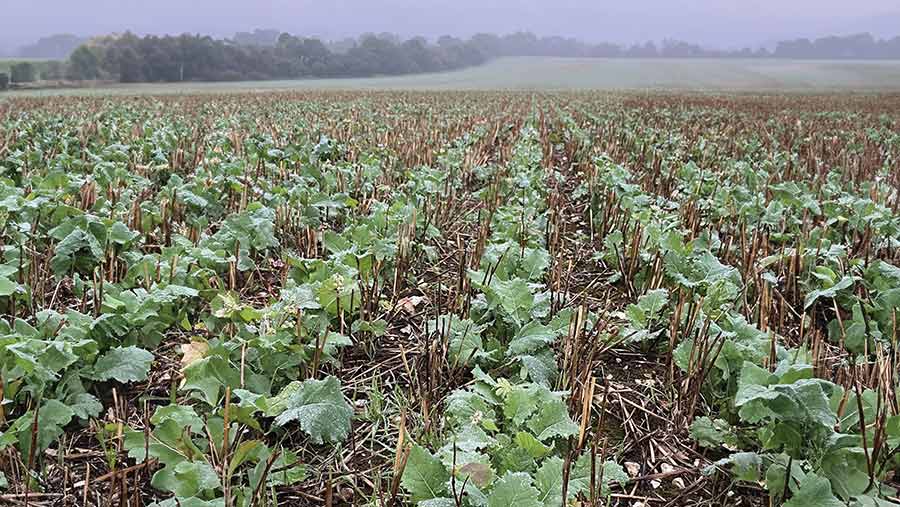Three practical IPM strategies to help growers cut input costs
 OSR and companion crop © David Miller
OSR and companion crop © David Miller Independent agronomist Ben Burrows of Crop Management Partners has been working closely with Hampshire farm manager David Miller to implement a number of IPM strategies and cut input costs at the AHDB Strategic Farm South.
David is farm manager of Wheatsheaf Farming, south-west of Basingstoke, where he farms 700ha of light loam soils over chalk land on both sides of the M3 motorway.
With the launch of Defra’s Sustainable Farming Incentive is offering farmers a £45/ha payment for crops managed without the use of insecticides (IPM4), which is appealing to some growers.
Ben talks us through the farm’s strategies, which has helped tackle barley yellow dwarf virus (BYDV) and wheat disease, and reduced the risk associated with growing oilseed rape.
See also: What the six additions bring to the new-look OSR Recommended List
What is integrated pest management?
Integrated pest management (IPM) is a co-ordinated strategy that controls pests, weeds and disease using cultural and nature-based solutions rather than chemical products.
The strategy could help growers overcome shrinking margins at a time when they are facing a continuous loss of plant protection products, and resistance fears build for remaining actives.
Together with the political drive for more sustainable farming practices, growers are seeking cost-effective alternatives, including IPM approaches, to provide solutions.
1. Low-risk oilseed rape
Despite the challenges associated with growing oilseed rape, David is keen to continue producing the crop for its value in the rotation.
Well aware of the increasing growing costs and risk of pest attacks, he aims to reduce input costs and thereby minimise risk.
In fact, David has more than halved oilseed rape production costs in the past 10 years, even with the chemical price rises of last year.
The figures below are David’s OSR variable costs, excluding nitrogen. Not only have they fallen, but also show the big variations year to year that are out of his control. Fixed costs are also much reduced with direct drilling and fewer sprayer passes, he says.
- 2011 £327.39/ha
- 2012 £362.91/ha
- 2013 £386.38/ha
- 2021 £128.87/ha
- 2022 £129.37/ha
- 2023 £169.31/ha

© David Miller
How did he achieve this?
First, David began using home-saved conventional seed where possible to provide an initial cheaper seed source right from the get-go.
This also selected plants with a genetic predisposition to be better suited to his farm environment.
David does not apply starter or seed-bed fertilisers to keep input costs down.
However, he drills the crop with a companion of buckwheat and two types of clover, berseem and crimson, to provide shelter and nutrients to the rapeseed.
This also acts as a potential disguise from cabbage stem flea beetle and, aside from the many soil benefits companion crops deliver, if the oilseed rape fails, the pass of the drill has not been wasted and the soil is covered, explains Ben.
Zero insecticides are applied to the crop – a testament to a decade’s worth of cover cropping that has seen beneficial insects thrive and soil health improve dramatically.
Usually, David does not apply an autumn fungicide either, as he opts for varieties with good phoma and light leaf spot resistance.
However, this season he is likely to apply a fungicide as phoma levels have been particularly high.
Monitoring crops closely on a season-by-season and field-by-field basis is, therefore, key.
The herbicide programme has remained largely unchanged from his traditional rapeseed and, consequently, makes up a significant proportion of production costs. Yields now average 3.5t/ha, but with minimal spend.
Six key principles of IPM
- Identification of pests, weeds and diseases
- Monitoring and assessing numbers and damage
- Following guidelines when management action is required
- Preventing pest problems
- Using a combination of biological, cultural, physical/mechanical and chemical management tools
- After action is taken, assessing the effects of pest management
2. Barley yellow dwarf virus control
BYDV in winter cereals was once a problem at David’s farming operation and insecticide sprays were used when threshold levels were met.
However, over the years the increase in cover cropping together with the reduction in cultivations have resulted in helping beneficial insect populations to thrive, which has reduced the threat of BYDV.
David typically drills winter cereals during the third week of September through to the first week of October to provide plenty of time to get crops up and away following his zero-till establishment method.
BYDV-tolerant varieties are not used at present due to limited choice, but Ben is particularly keen for growers to look into this as a means of cutting their reliance on insecticides.
Aphids can usually be found during autumn crop inspections. Populations are monitored closely and the AHDB aphid treatment tool is used to see if threshold levels have been reached.
Most of the farm is at an elevation of 120-200m, which David and Ben believe could help reduce aphid populations.
“Although I know the goal is for little or ideally no insecticide use, I would always try to give David an honest appraisal if I felt certain fields were likely ‘higher risk’ due to early drilling date, lower elevation, or if a lot of aphids are easily found,” says Ben.
3. Zero-fungicide winter wheat
A three-way feed variety wheat blend of Graham, Dawsum and Champion was grown last year, with the aim of using genetic diversity to reduce disease pressure, particularly from septoria.
Nitrogen rates for the wheat blend were cut back to 120kg/ha from the farm standard of 180kg/ha.
A foliar spray containing nitrogen and sulphur topped this up to a total nitrogen content of 137kg/ha.
Despite the reduced inputs of the wheat blend trial, yields were the same when compared with a single-variety crop grown on the same soil and previous cropping.
Ben notes that the farm trial provides the basis for further experimentation and discussion.
“What’s more, carrying out different trial work across the farm is something different/fun to get involved with,” he says.
Relationship between growers and advisers critical for optimum IPM implementation
There is desire for farmers and growers to reduce their reliance on artificial inputs and instead use biological products.
However, the relationship between agronomist and growers is critical for this success, says Ben Burrows, independent agronomist at Crop Management Partners.
There is little or no reliable scientific evidence available for how these practices work, so growers have to be prepared to do their own research, learn from their own successes and failures and share knowledge with other farmer and advisers, he adds.
How are agronomic decisions made? Is the risk shared between both agronomist and farmer?
“When trialling new ideas on farm, try to work out where your attitude to risk lies. Be prepared to try something different, but in a way that does not take large, unnecessary risks,” he advises.
“You may not always completely agree with ideas from agronomists and advisers, but it’s important to have the discussion.
“Try to explain the risks of doing/not doing something that is an established convention.”
For example, ask yourself ‘What happens if we don’t apply the T3 ear wash fungicide?’ and use this as a way of assessing risks and thinking of new ways to overcome problems.

